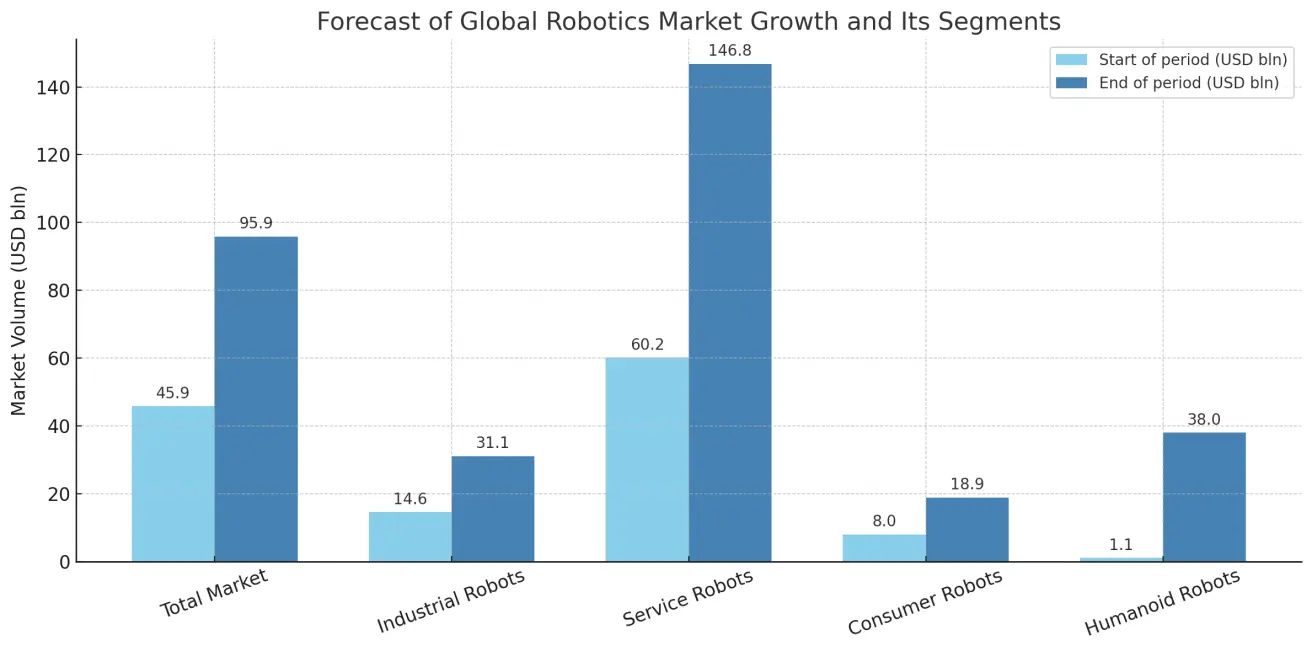Apptronik Leads the Robotics Revolution
Insights on the robotics boom by Andrei Berezin, co-founder at Raison

Robotics Is No Longer Fiction
Robotics is no longer the stuff of science fiction — it is a transformative reality reshaping the world. Artificial intelligence (AI), labor shortages, and aging populations are accelerating the industry’s growth. Venture capital is paying close attention to this space, and companies like Apptronik are setting the pace in the humanoid robotics race. Let’s explore why the robotics market is surging, who is investing in it, and how Apptronik is outpacing even giants like Tesla.
A Market on the Rise
The global robotics market is growing rapidly. According to Mordor Intelligence, its value reached $45.85 billion in 2024 and is projected to grow to $95.93 billion by 2029, with a compound annual growth rate (CAGR) of 15.91%. Various market segments are demonstrating impressive momentum:
- Industrial Robots: From $14.61 billion in 2020 to $31.13 billion by 2028 — automation is revolutionizing manufacturing, electronics, and automotive industries.
- Service Robots: Logistics, healthcare, and defense are driving this segment from $60.16 billion in 2024 to $146.79 billion by 2029.
- Consumer Robots: From robotic vacuum cleaners to lawnmowers — the market will grow from $7.98 billion in 2023 to $18.90 billion by 2028.
- Humanoid Robots: Currently a niche segment, it started at $1.1 billion in 2023 but could reach $38 billion by 2035.
This growth is fueled by breakthroughs in AI, machine vision, and automation — trends further accelerated by supply chain disruptions and labor shortages. The Asia-Pacific region leads in volume, while the U.S. drives innovation, holding a 52.4% share of the humanoid robot market in 2024 (Market Research Future).

Venture Capital Eyes Robotics
Investors are increasingly eyeing the robotics sector. In 2013, robotics startups attracted $235 million — just 0.5% of global venture capital. Today, the tide is turning in favor of the sector, with humanoid robots at the forefront. The “Robots as a Service” (RaaS) model lowers barriers for small businesses, making the sector even more appealing.
Challenges remain: high R&D costs, long development cycles, and inherent risks still deter some investors. However, faith in AI and robotics potential outweighs these concerns. The U.S. dominates VC activity, Japan leads in humanoid development, and China is ramping up demand through its “Made in China 2025” initiative.
Raison continues to make confident moves in the venture space — just recently, we successfully closed a $2.4 million investment in Apptronik shares.
Apptronik: The Star of Humanoid Robotics
Based in Austin, Texas, Apptronik is not merely a startup but a flagship in humanoid robotics. Its Apollo robot — built on NASA’s engineering legacy and powered by AI from Google DeepMind — is already transforming manufacturing, logistics, and elder care. The company dreams big, and the market is taking notice.
-
Financial Triumph: Apptronik raised $403 million in a Series A round, securing backing from heavyweights such as Google DeepMind, Mercedes-Benz, and B Capital. These funds are fueling the scaling of Apollo, which is learning autonomously — leaving competitors with pre-programmed tasks behind.
-
Technological Breakthrough: Apollo integrates DeepMind’s AI and NASA’s engineering expertise, enabling it to adapt to the real world’s inherent chaos. CEO Jeff Cardenas states: “AI removes old barriers — robots can now tackle tasks previously thought impossible.”
-
Market Ambitions: Apptronik is targeting logistics and healthcare sectors, where humanoid robots address labor shortages and the challenges of an aging population. Cardenas emphasizes a human-centric approach: their robots are “technology with soul,” designed to preserve human dignity.
While Elon Musk’s Tesla grapples with raw material supply disruptions for its Optimus robots due to trade tensions with China, Apptronik holds a strategic edge. Their supplier, Jabil, maintains access to global supply chains, avoiding dependence on Chinese raw materials. This gives Apptronik a competitive advantage, especially considering China controls 80% of the global gallium market and 60% of the germanium market.
Challenges and The Road Ahead
High costs, regulatory hurdles, and ethical dilemmas surrounding AI require a nuanced approach. Globally, the industry must address concerns over job displacement and ensure technology remains accessible.
By 2030, the market is poised for another leap. AI, 5G, and edge computing will enable autonomous delivery, surgical robotics, and more. Humanoid robotics — a field where Apptronik is already leading — will become the core of this transformation. Venture activity will intensify, and local players, including Kazakhstani funds, will increasingly join the race.
Apptronik and its Apollo robot are not merely participants but shapers of the future. With strong financial backing, global partnerships, and resilience against trade disruptions, Apptronik is not simply riding the wave of robotics — it is creating it.
 Қазақша
Қазақша